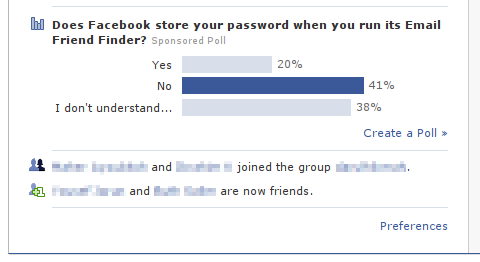
Facebook Messenger, from the team notorious for using 18,000 classes to create a simple iOS app, is back to teach you one more lesson: how to stupidly use up as much valuable screenspace as possible:


Facebook Messenger, from the team notorious for using 18,000 classes to create a simple iOS app, is back to teach you one more lesson: how to stupidly use up as much valuable screenspace as possible:
In the age of Facebook, in an era where privacy and anonymity are a thing of the very distant past, quite a few “features” of technology have been banished from daily use, forced to languish in the corner in a sad state of disuse and disrepair. But perhaps none have suffered such a miserable and regrettable fate as the BCC.
Quick: if you’re fighting with a friend and want to let your BFF know what’s going on as you send your frenemy a nasty messsage — what’s the best way to pull that off?
If you’ve completed the switch to Facebook mindset, your convoluted answer would consist of something to effect “Send a message to X, copy and paste it, and send it to Y.” And you’d be right – Facebook doesn’t give you another way of pulling this off. FAIL!
Let’s say your technical skills are not in such a pitiful state and you have enough sense to still use email for day-to-day communications. What’s your answer then? “I’ll just send X an email, then forward my result to Y.” aaaaaaaaand that’s another fail.
See, there’s this oft-overlooked feature my commandline mail client from the 80s has that solves this. It’s called “Blind Carbon Copy,” or BCC for short. You can send an email to more than one person without all your recipients knowing who you sent it to!
There’s a screenshot that’s been sitting on my desktop for a rather long time now, and it’s as scary as it is interesting.
Facebook recently conducted a poll which showed up on the homepage newsfeed, and asked Facebook members just how exactly did they think Facebook’s “friend finder” worked when it prompted them for their email address & password in order to get a list of contacts. The numbers pretty much speak for themselves, here’s what they looked like near the end of the campaign:

Now ignore the dark blue bar: it’s a red herring and doesn’t contain any interesting info. The real juicy bit is the “Yes” option, and its 20% response.
Facebook has one of the world’s largest server farms and for good reason – with all that traffic no amount of servers can be considered too much. While Facebook’s uptime is a lot better than many most of the other “Web 2.0” services, we’ve been seeing a lot of maintenance-related downtime recently (see possible reasons below).
You’ve got to hand it to the Facebook team though, they have scaling and uptime perfected down to an art. For instance, when servers are due for updates, the maintenance is performed in a staggered manner, updating one set of servers at a time as attested to by the unavailability of certain Facebook accounts while others can still be accessed.
If your account is on one of he servers being serviced/maintained/upgraded, you’ll see a message like this:
Just yesterday, Michelle Slatalla of The New York Times posted an article about her joining Facebook – where her daughter & friends have had accounts for quite a while. Her reason? Probably best put in her own words:
So last week I joined Facebook, the social network for students that opened its doors last fall to anyone with an e-mail address. The decision not only doubled its active membership to 24 million (more than 50 percent of whom are not students), but it also made it possible for parents like me to peek at our children in their online lair.1
But adults – and more specifically, parents – don’t belong on Facebook. Not because the system isn’t built for people over 30 nor because adults aren’t interested in moving existing relationships online, but only because Facebook and other Web 2.0 social network sites for students (and teens, too) are now what the mall was five years ago.
While Ms Slatalla goes off on a tangent, choosing to discuss the existence of mother-daughter ties online and her own troubled past (or something), there is a bigger picture there: why Facebook is so popular. Web 2.0 is all about taking things for real-life and putting them online.
Photo albums? Flickr. Diaries? Blogs. Home videos? YouTube. Book store? Amazon. Auction? eBay. And so on and so forth. So what does that make Facebook? Why Mall 2.0 of course!
Emphasis added. ↩
Twitter is all the hype right now, you don’t need us to tell you that. For some odd reason, something as simple and basic as a one-liner blog site has captured the minds of the online world. For two minutes, put aside whatever feelings you may have on the matter. Good or bad, just set them aside for a couple of minutes and look at it from a different point of view.
Let’s take the best-case scenario here. Twitter continues to increase in popularity, and can handle any and all problems that come up with their system. Let’s assume Twitter keeps on booming. What happens next?
As with all other social networks, the goal of Twitter is connections. NeoSmart Technologies connects ideas, Twitter connects people. Now there are a billion people on Twitter: they check out each other’s profiles, and get to one-another. What then? They head off to each person’s blog, Facebook, or even MySpace to get in touch: leave one another messages, check out their friends, share ideas, photos, and videos.
At the end of the day, people are going to be leaving Twitter to go to their friends’ blogs and sites, and hooking up with them there. The point is, Twitter isn’t filling the void. It fills up a small portion of it, but not enough to satisfy. If at the end of the day, people are going to leave it for other sites, they’ll stop going back.